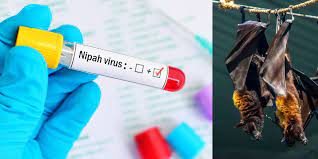
Situation at a glance
From the 12 to 15 September 2023, the Ministry of Health and Family Welfare, Government of India, reported six laboratory-confirmed Nipah virus cases, including two deaths, in Kozhikode district, Kerala. Aside from the first case, whose source of infection is unknown, the other cases were family and hospital contacts of the first case. As of 27 September 2023,1288 contacts of the confirmed cases were traced, including high-risk contacts and healthcare workers, who are under quarantine and monitoring for 21 days. Since 12 September, 387 samples have been tested, of which six cases were positive for Nipah virus infection, and all remaining samples tested negative. Since 15 September, no new cases have been detected. This is the sixth outbreak of Nipah virus in India since 2001.
Nipah virus infection, a zoonotic illness, is spread to humans through contact with infected animals such as bats and pigs. Additionally, direct contact with an infected individual can also lead to transmission, although this route is less common. Those affected by Nipah virus infection may experience severe symptoms, including acute respiratory infection and fatal encephalitis. The only way to reduce or prevent infection in people is by raising awareness about the risk factors and preventive measures to protect themselves. Case management should focus on providing patients with supportive care measures and intensive support for severe respiratory and neurologic complications.
State and national authorities activated a multisectoral coordination and response mechanism to contain the spread of the outbreak including enhanced surveillance and contact tracing, laboratory testing of suspected cases and high-risk contacts, hospital preparedness for case management, infection prevention and control (IPC), risk communication and community engagement.
Description of the situation
Between 12 and 15 September 2023, a total of six laboratory-confirmed cases of Nipah virus infection including two deaths were reported by the State Government of Kerala. All confirmed cases were males within the age range of 9 to 45 years old and were reported within the Kozhikode district of Kerala.
The first case whose source of infection is unknown, had pneumonia and acute respiratory distress syndrome (ARDS) and was admitted at a hospital in late August 2023. He died a few days after admission. The other five confirmed cases were close contacts of the first case including two family members and contacts at the hospital where the first case was treated and died. The second death occurred in an individual who accompanied another patient to the hospital where the first case was being treated. He died after presenting with symptoms of pneumonia.
As of 27 September 2023, 1288 contacts of the confirmed cases have been traced, including high-risk contacts and healthcare workers who treated the confirmed cases and processed their samples. All identified contacts are under quarantine for a period of 21 days. As of 27 September 2023, the four cases remain clinically stable.
The Government’s response measures included declaring containment zones in nine villages in the Kozhikode district with movement restrictions, social distancing, and mandatory mask-wearing in public spaces. The government restricted major public events in Kozhikode district until 1 October 2023. Alerts were issued to neighbouring districts and states for enhanced surveillance.
According to the National Institute of Virology (NIV), Pune, the virus found in Kerala has been identified as the Indian Genotype or I-Genotype and is similar to the Nipah virus strain found in Bangladesh.
Epidemiology of the disease
Nipah virus infection is an emerging bat-borne zoonotic disease transmitted to humans through infected animals (such as bats and pigs) or food contaminated with saliva, urine, and excreta of infected animals. It can also be transmitted directly from person to person through close contact with an infected person (although this represents a less common transmission route).
Nipah virus infection in humans causes a range of clinical presentations including acute respiratory infection and fatal encephalitis. The case-fatality rates in outbreaks across Bangladesh, India, Malaysia, and Singapore typically range from 40% to 100%. As of now, there are no available effective therapies or vaccines for this disease.
The current outbreak is the third Nipah virus outbreak in Kozhikode district, Kerala, the fourth outbreak in Kerala state since 2018 and the sixth outbreak in India. Similar to the previous outbreak in 2018 in Kerala, this outbreak started with the first case and subsequent clustering of cases in family contacts and likely nosocomial transmission in hospitals. In the WHO South-East Asia Region, only Bangladesh and India have reported Nipah virus outbreaks.
Public health response
The following public health response measures were implemented by the Department of Health and Family Welfare, State Government of Kerala, with support from the Ministry of Health and Family Welfare, Government of India, and its institutions; Indian Council of Medical Research (ICMR), National Institute of Virology (NIV), Pune, and National Institute of Epidemiology, Chennai.
Coordination: Multiple central multi-disciplinary teams were mobilized by the Department of Health & Family Welfare, Department of Health Research as well as Department of Animal Husbandry to support the State and District administration in containment and mitigation measures. A total of 19 core committees were created and tasked with various response measures including surveillance, sample testing, contact tracing, patient transportation, case management, logistics and supplies, training and capacity building, risk communication and community engagement, psychosocial support and animal husbandry. A control room with a call center was activated in the district to coordinate the response activities.
Surveillance and contact tracing: As part of community-based surveillance activities, active house-to-house surveillance was carried out by the district health authorities in the containment zones declared. A total of 53,708 houses have been surveyed as of 27 September 2023. As of 27 September, 1288 contacts including high-risk contacts were identified and quarantine with follow up exercise ongoing. All high-risk contacts were tested. Containment zones were declared in nine villages in Kozhikode district with movement restrictions, social distancing and mandatory mask-wearing in public spaces. The government restricted major public events in Kozhikode district until 1 October 2023. Alerts have been issued to neighbouring districts and states for enhanced surveillance.
Laboratory testing: Laboratory testing of suspected cases as well as environmental and animal samples is being conducted at the Regional Viral Research and Diagnostic Laboratory network lab at the Government Medical College (GMC), Kozhikode; Indian Council of Medical Research (ICMR) Mobile BSL-3 lab; Field unit of NIV at Alappuzha as well as NIV, Pune. As of 27 September 2023, no environmental/animal samples (including bats) have tested positive for Nipah virus.
Health facility preparedness: Emergency departments have been equipped to handle any suspected cases and respond to emergencies. Isolation rooms and intensive care units (ICU) are being kept ready to treat suspected cases, where required. The State has earmarked isolation rooms, ICU beds, and ventilators to mount surge capacity when needed. Suspected and confirmed cases are being managed at designated health facilities. For patient transport, dedicated ambulances have been mobilized.
Infection prevention and control: The State Government has initiated training of healthcare workers on infection prevention and control (IPC). Adequate stocks of Personal Protective Equipment (PPEs) have been made available to health care workers and IPC practices are being strictly adhered to and audited.
Logistic management: Adequate stocks of PPEs, drugs and other requisite logistics are being provided by the State Government.
Dead body management: Arrangement has also been made for the transfer and management of dead bodies by the State Government in compliance with the standard protocol and IPC precautions.
Risk communication and community engagement: Information education and communication activities through different modalities (including regular press releases) have been initiated. Further, audio spots and video bytes by expert doctors are being issued. Infodemic management strategies are currently being implemented with strict action taken against fake news. A call center to provide psychosocial care has also been established by the State Government.
Animal Sector: Samples of bats, animal droppings, and half-eaten fruits were collected on 15 September from the village where the first case lived, in a 300-acre (121-hectare) forest which is home to several bat species. All samples tested negative for Nipah virus.
Public health response measures were implemented in accordance with the guidelines developed by the State Government and Government of India with support from WHO and partners during the 2018 Nipah virus outbreak in Kerala state.
WHO risk assessment
This is the sixth outbreak in India since 2001 when the first outbreak was reported in Siliguri town, West Bengal (66 cases, CFR: 68%). Subsequently, five outbreaks have been reported- Nadia district, West Bengal (5 cases; CFR: 100%), Kozhikode and Malappuram, Kerala in 2018 (23 cases including confirmed and probable; CFR: 91%), Ernakulum, Kerala in 2019 (a single case who survived) and Kozhikode, Kerala in 2021 (one case, CFR: 100%).
The following factors may contribute to the risk associated with this outbreak:
- The exposure of the first case in this outbreak remains unknown;
- The presence of a bat population which has been reported to harbor Nipah virus and therefore acts as a potential source of infection;
- High reported case fatality rate (33.3%) and high number of contacts; and
- The absence of Nipah virus-specific therapeutics and vaccines.
At the same time, the current outbreak is not entirely unexpected and is the third outbreak in Kozhikode district and fourth in the state of Kerala. Current cases are clustered and epidemiologically linked to the first case, and cases are localized to Kozhikode district. Public health teams and health care workers in Kozhikode have prior experience in managing outbreaks of Nipah virus infection. The State Government has rapidly established response measures to contain the spread of the outbreak and through enhanced surveillance and contact tracing measures, 1288 contacts have been identified and are under monitoring. High-risk contacts are being tested.
WHO advice
In the absence of a vaccine or licensed treatment available for Nipah virus, the only way to reduce or prevent infection in people is by raising awareness of the risk factors and educating people about the measures they can take to reduce exposure to Nipah virus infection. Case management should focus on the delivery of supportive care measures to patients. Intensive supportive care is recommended to treat severe respiratory and neurologic complications.
Public health educational messages should focus on:
Reducing the risk of bat-to-human transmission
Freshly collected date palm juice should be boiled, and fruits should be thoroughly washed and peeled before consumption. Fruits with signs of bat bites should be discarded. Areas where bats are known to roost should be avoided. The risk of international transmission via fruit or fruit products (such as raw date palm juice) contaminated with urine or saliva from infected fruit bats can be prevented by washing them thoroughly and peeling them before consumption.
Reducing the risk of animal-to-human transmission
Natural infection in domestic animals has been described in farming pigs, horses, and domestic and feral cats. Gloves and other protective clothing should be worn while handling sick animals or their tissues and during slaughtering and culling procedures. As much as possible, people should avoid being in contact with infected pigs. In endemic areas, when establishing new pig farms, consideration should be given to the presence of fruit bats in the area and in general, pig feed and pig sheds should be protected against bats when feasible. Samples taken from animals with suspected Nipah virus infection should be handled by trained staff working in suitably equipped laboratories.
Reducing the risk of human-to-human transmission
Close unprotected physical contact with Nipah virus infected people should be avoided. Regular hand washing should be carried out after caring for or visiting sick people. Health care workers caring for patients with suspected or confirmed infection, or those handling their specimens, including trained staff working in suitably equipped laboratories, should always implement infection prevention and control standard precautions as well as contact and droplet precautions when providing care or working in the rooms of patients with suspected or confirmed Nipah virus and when handling/managing linens or waste from patients with Nipah virus. Case management should focus on the delivery of supportive care measures to patients. Intensive supportive care is recommended to treat severe respiratory and neurologic complications. Safe burial practices are required for all confirmed and suspected Nipah virus infected cases.
Infection prevention and control
In health care settings, patients who are suspected of Nipah virus should be isolated in well-ventilated single rooms with dedicated patient equipment and toileting. Patients with suspected Nipah virus should not be placed in cohort rooms. Health care workers interacting with patients with Nipah virus should use contact and droplet precautions when caring for patients with Nipah virus. Contact, droplet, and airborne precautions should be used, including placement of a patient in an airborne isolation room when aerosol-generating medical procedures are performed. If airborne isolation rooms are not available, a well-ventilated single room with windows open if using natural ventilation with doors to corridors closed. Cleaning and disinfection of all surfaces in patient rooms housing suspected or confirmed patients with Nipah virus should occur at least once daily. After cleaning with soap and water, a 0.5% sodium hypochlorite solution disinfectant should be applied to surfaces, remaining untouched for 5 minutes contact time. Immediate cleaning and disinfection, as well as high touch surface cleaning, should be performed whenever a spill of blood or body fluid occurs. Health facilities should be equipped with enhanced water, sanitation and hygiene services to meet the needs of staff, patients and caregivers. Safe waste management practices should be adhered to by the health care facilities.
WHO infection prevention and control advice when caring for patients with Nipah virus infection is currently under review and is pending update.
WHO advises against the application of any travel or trade restrictions on India based on the current information available on this event.
Further information
- WHO. Nipah virus infection. https://www.who.int/health-topics/nipah-virus-infection#tab=tab_1
- Yadav PD, Shete AM, Kumar GA, Sarkale P, Sahay RR, Radhakrishnan C, et al. Nipah Virus Sequences from Humans and Bats during Nipah Outbreak, Kerala, India, 2018. Emerg Infect Dis. 2019 May;25(5):1003-1006.
- Arunkumar G, Chandni R, Mourya DT, Singh SK, Sadanandan R, Sudan P, et al. Outbreak Investigation of Nipah Virus Disease in Kerala, India, 2018, The Journal of Infectious Diseases. 2019; 219 (12): 1867–1878, https://doi.org/10.1093/infdis/jiy612
- Sudeep AB, Yadav PD, Gokhale MD, Balasubramanian R, Gupta N, Shete A, et al. Detection of Nipah virus in Pteropus medius in 2019 outbreak from Ernakulam district, Kerala, India. BMC Infect Dis, 2021; 21: 162. https://doi.org/10.1186/s12879-021-05865-7
- ICMR-NIV survey finds proof of Nipah virus in bats across nine states, one UT, The Indian Express (news article), Updated: July 26, 2023. https://indianexpress.com/article/cities/pune/icmr-niv-survey-finds-proof-of-nipah-virus-in-bats-across-nine-states-one-ut-8860154/
- Department of Health and Family Welfare, Government of Kerala. https://dhs.kerala.gov.in/wp-content/uploads/2021/09/Nipah-Guidelines-9-04-21-2-1.pdf
- Government of Kerala press release. https://www.prd.kerala.gov.in/ml/node/232856
- Government of Kerala press release. https://www.prd.kerala.gov.in/ml/node/232700
- Government of Kerala press release. https://www.prd.kerala.gov.in/index.php/ml/node/231325
- Government of Kerala press release. https://www.prd.kerala.gov.in/ml/node/231783
- Government of Kerala press release. https://www.prd.kerala.gov.in/ml/node/230905
- Government of Kerala press release. https://www.prd.kerala.gov.in/ml/node/231067
- Government of Kerala press release. https://www.prd.kerala.gov.in/ml/node/232705
- Government of Kerala press release. https://www.prd.kerala.gov.in/ml/node/232481
Citable reference: World Health Organization (03 October 2023). Disease Outbreak News; Nipah Virus Infection in India. Available at: https://www.who.int/emergencies/disease-outbreak-news/item/2023-DON490










